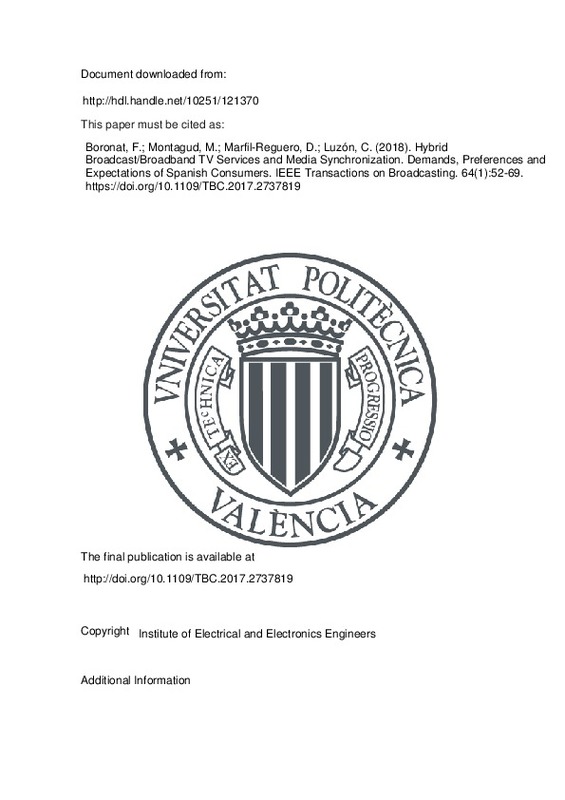JavaScript is disabled for your browser. Some features of this site may not work without it.
Buscar en RiuNet
Listar
Mi cuenta
Estadísticas
Ayuda RiuNet
Admin. UPV
Hybrid Broadcast/Broadband TV Services and Media Synchronization. Demands, Preferences and Expectations of Spanish Consumers
Mostrar el registro sencillo del ítem
Ficheros en el ítem
| dc.contributor.author | Boronat, Fernando
|
es_ES |
| dc.contributor.author | Montagud, Mario
|
es_ES |
| dc.contributor.author | Marfil-Reguero, Daniel
|
es_ES |
| dc.contributor.author | Luzón, Clara
|
es_ES |
| dc.date.accessioned | 2019-05-31T20:43:46Z | |
| dc.date.available | 2019-05-31T20:43:46Z | |
| dc.date.issued | 2018 | es_ES |
| dc.identifier.issn | 0018-9316 | es_ES |
| dc.identifier.uri | http://hdl.handle.net/10251/121370 | |
| dc.description | © 2018 IEEE. Personal use of this material is permitted. Permissíon from IEEE must be obtained for all other uses, in any current or future media, including reprinting/republishing this material for advertisíng or promotional purposes, creating new collective works, for resale or redistribution to servers or lists, or reuse of any copyrighted component of this work in other works. | |
| dc.description.abstract | [EN] The combination of broadcast and broadband ( hybrid) technologies for delivering TV related media contents is already a reality. It has been motivated by the large amount and diversity of media contents, together with the ubiquity and multiple connectivity capabilities of modern consumption devices. The use of connected TVs and companion devices (e.g., tablets, smartphones etc.) is gaining momentum. It enables personalized and enriched TV media experiences, by also exploiting social communication opportunities. Likewise, the media consumption paradigm is worldwide evolving from passive and isolated consumer experiences toward interactive and group shared experiences between remote consumers. Nevertheless, despite the specification of standards, such as hybrid broadcast broadband TV, and the efforts from operators and content providers in the last years, the adoption of hybrid TV media services in Europe is still not as high as expected. This paper presents the concept and some examples of hybrid TV media services, emphasizing the importance of including a combination of media synchronization solutions, known as hybrid sync, to guarantee a satisfactory level of quality of experience. Additionally, it includes the summary and discussion of the results of a research study focused on more than 1000 Spanish users' habits, preferences, and expectations regarding four representative hybrid TV media services. Many valuable insights and conclusions have been derived. For instance, the current low market adoption of hybrid TV media services, despite their advantages and the high interest of consumers, and that key technological challenges still need to be overcome. The obtained results and impressions foresee the impact (or potential) of such services in the upcoming TV related media consumption landscape. Therefore, devising proper standard-compliant technological solutions (paying special attention to hybrid sync) and equipment should be continued producing appropriate contents, deploying proper hybrid TV media services and applications. As well, it should be convenient to undertake marketing and commercial efforts to boost their deployment. The contributions of this paper can be very valuable to the interested agents to be aware of the remaining challenges, envisage the opportunities, and drive their efforts to maximize the market adoption of such services. | es_ES |
| dc.description.sponsorship | This work was supported in part by the Fondo Europeo de Desarrollo Regional, in part by the Spanish Ministry of Economy and Competitiveness under Its R&D&I Support Program under Project TEC2013-45492-R. | es_ES |
| dc.language | Inglés | es_ES |
| dc.publisher | Institute of Electrical and Electronics Engineers | es_ES |
| dc.relation.ispartof | IEEE Transactions on Broadcasting | es_ES |
| dc.rights | Reserva de todos los derechos | es_ES |
| dc.subject | Broadcast technology | es_ES |
| dc.subject | Digital multimedia broadcasting | es_ES |
| dc.subject | TV broadcasting | es_ES |
| dc.subject | HbbTV | es_ES |
| dc.subject | Connected TV | es_ES |
| dc.subject | Interactive TV | es_ES |
| dc.subject | Social TV | es_ES |
| dc.subject | Media synchronization | es_ES |
| dc.subject | QoE | es_ES |
| dc.subject.classification | INGENIERIA TELEMATICA | es_ES |
| dc.title | Hybrid Broadcast/Broadband TV Services and Media Synchronization. Demands, Preferences and Expectations of Spanish Consumers | es_ES |
| dc.type | Artículo | es_ES |
| dc.identifier.doi | 10.1109/TBC.2017.2737819 | es_ES |
| dc.relation.projectID | info:eu-repo/grantAgreement/MINECO//TEC2013-45492-R/ES/SINCRONIZACION HIBRIDA E INTER-DESTINATARIO (IDMS) PARA POSIBILITAR EXPERIENCIAS MULTIMEDIA ENRIQUECIDAS, PERSONALIZADAS, INMERSIVAS Y COMPARTIDAS/ | es_ES |
| dc.rights.accessRights | Abierto | es_ES |
| dc.contributor.affiliation | Universitat Politècnica de València. Departamento de Comunicaciones - Departament de Comunicacions | es_ES |
| dc.contributor.affiliation | Universitat Politècnica de València. Escuela Politécnica Superior de Gandia - Escola Politècnica Superior de Gandia | es_ES |
| dc.description.bibliographicCitation | Boronat, F.; Montagud, M.; Marfil-Reguero, D.; Luzón, C. (2018). Hybrid Broadcast/Broadband TV Services and Media Synchronization. Demands, Preferences and Expectations of Spanish Consumers. IEEE Transactions on Broadcasting. 64(1):52-69. https://doi.org/10.1109/TBC.2017.2737819 | es_ES |
| dc.description.accrualMethod | S | es_ES |
| dc.relation.publisherversion | http://doi.org/10.1109/TBC.2017.2737819 | es_ES |
| dc.description.upvformatpinicio | 52 | es_ES |
| dc.description.upvformatpfin | 69 | es_ES |
| dc.type.version | info:eu-repo/semantics/publishedVersion | es_ES |
| dc.description.volume | 64 | es_ES |
| dc.description.issue | 1 | es_ES |
| dc.relation.pasarela | S\352430 | es_ES |
| dc.contributor.funder | Ministerio de Economía, Industria y Competitividad | es_ES |







![[Cerrado]](/themes/UPV/images/candado.png)

